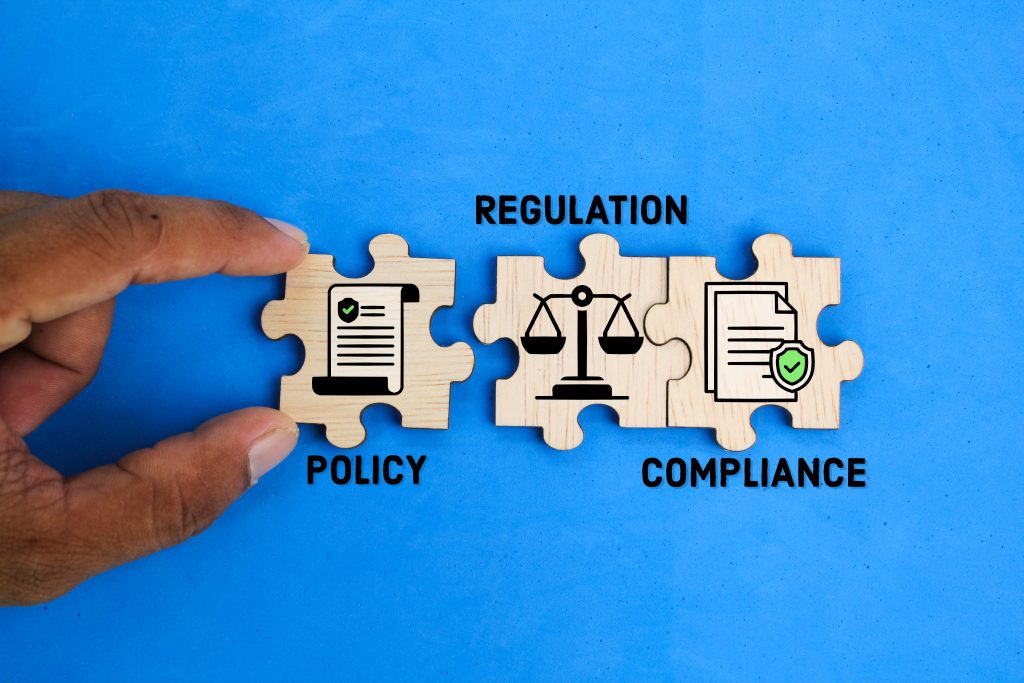In today’s workplace, compliance isn’t just a checkbox—it’s a business imperative. But so is culture.
As we move through 2025, HR leaders face a crucial challenge: maintaining full compliance with constantly evolving regulations while preserving the authentic culture and values that define their organizations. This means ensuring that HR policies and practices align not only with legal requirements—covering hiring, wage management, employee classification, workplace safety, anti-discrimination, leave, and termination—but also with emerging demands like data privacy, remote work regulations, DEI mandates, and ethical AI use. Striking this balance is essential to keeping your business audit-ready without sacrificing the human element at work.

HR compliance goes beyond simply avoiding penalties. It’s about building trust and creating an environment where employees feel safe, respected, and valued. When workers know their rights are upheld and policies are applied fairly and transparently, engagement and morale improve. In today’s workplace, compliance and culture are deeply interconnected—fostering one supports the other, helping organizations become more resilient and people-focused.
Importantly, HR compliance is not a one-time checkbox but a continuous process. Regulations can shift rapidly, so companies need proactive systems that adapt in real time. Ultimately, effective HR compliance means crafting workplaces where legal integrity and human dignity go hand in hand, because doing what’s right under the law often means doing what’s right for your people.
Why HR Compliance Matters More Than Ever
HR compliance is more than a legal requirement—it’s a strategic asset. Without it, companies face confusion, inconsistency, and potentially costly setbacks. Here’s why getting compliance right is crucial:
- Avoids legal and financial penalties
Failure to comply with employment laws can result in lawsuits, government fines, and audits—draining both time and resources. A simple error in wage classification or overtime rules can quickly escalate into a costly six-figure issue. Proactively managing compliance helps prevent these risks before they arise. - Builds employee trust and transparency
When employees know their rights and see them upheld, it strengthens trust and engagement. Compliance ensures fair treatment across the board, reinforcing that your policies are more than words—they’re enforced and consistent, building a culture of accountability.
- Protects against discrimination and bias
HR compliance includes adhering to anti-discrimination laws and fostering equitable workplace practices. This minimizes bias in hiring, promotions, and compensation decisions, creating an inclusive environment that reflects both legal standards and ethical values. - Streamlines processes and documentation
Well-defined policies and meticulous record-keeping empower HR teams to operate efficiently. From onboarding to offboarding, a compliant framework removes guesswork and supports consistency, helping HR deliver a smoother employee experience at every stage. - Supports better decision-making
A strong compliance foundation provides managers with clear guidelines for navigating sensitive situations. Whether addressing performance issues or managing leaves of absence, policy-driven decisions reduce ambiguity and protect both individuals and the organization. - Reinforces company values through action
Compliance isn’t just about following the rules—it’s about living your values. By aligning HR practices with both legal and ethical standards, you demonstrate that your culture is principled, consistent, and committed to doing what’s right.

The Key Role of HR in Maintaining Compliance
From recruitment to exit interviews, HR is at the heart of ensuring that company practices align with both legal requirements and ethical principles. Here’s how that role plays out in practice:
- Creating legally sound policies
HR is responsible for developing policies that not only meet current labor laws and industry regulations but also reflect the organization’s core values. Whether it involves leave policies, compensation frameworks, or codes of conduct, these guidelines form the compliance foundation of the business. - Training managers and employees
Having policies in place is just the beginning—ensuring people understand and follow them is equally essential. HR leads training initiatives to educate staff on topics like workplace behavior, anti-discrimination laws, cybersecurity, and data privacy, helping prevent issues before they arise. - Ensuring accurate documentation
From job offers to disciplinary records, HR ensures every document is correctly maintained and legally compliant. Proper documentation serves as a safeguard for the company, especially during audits, disputes, or legal reviews.
- Handling employee grievances fairly
When concerns surface—whether it’s a harassment complaint, a discrimination issue, or interpersonal conflict—HR steps in to investigate and resolve matters according to legal standards. This not only ensures fairness but also reinforces a culture of trust and accountability. - Monitoring regulatory changes
Labor laws and compliance regulations are constantly evolving. HR keeps a close eye on these changes, making timely updates to internal policies and practices to ensure the company remains compliant and ahead of potential risks. - Supporting leadership with compliance insights
HR acts as a strategic partner to leadership, translating complex legal requirements into actionable guidance. By advising on compliance-related decisions, HR helps executives reduce legal risk while preserving the company’s culture and values.
Types of Compliance in HR
Compliance in HR spans multiple categories, each aligning with different phases of the employee experience. Here’s a breakdown of the key types:
- Legal (Statutory) Compliance
This refers to laws mandated by government authorities, including minimum wage regulations, overtime rules, tax obligations, and workplace safety standards. HR is responsible for ensuring these baseline legal requirements are met, minimizing the risk of fines, audits, or legal disputes. It forms the foundational layer of HR compliance. - Industry Regulatory Compliance
Beyond general labor laws, regulatory compliance includes rules established by industry-specific agencies. For example, OSHA governs workplace safety, while HIPAA regulates healthcare data privacy. These standards are often more detailed and vary by sector, requiring HR to stay current and adaptable based on the organization’s operating environment. - Contractual Compliance
This involves adhering to the terms agreed upon in employment contracts, vendor agreements, or union negotiations. Whether it’s honoring benefits, notice periods, or job expectations, HR ensures that what’s committed in writing is followed in practice—reducing misunderstandings and building credibility. - Collective Bargaining and Union Compliance
In unionized settings, HR must uphold the terms set forth in collective bargaining agreements. These can cover wages, job roles, dispute resolution protocols, and working conditions. Failing to comply with these agreements can result in serious consequences, including strikes or legal challenges. - Data Privacy and Security Compliance
With the increased use of digital HR systems and hybrid work models, protecting employee data has become a top priority. HR must comply with regulations such as GDPR or local privacy laws, ensuring that personal information is securely stored, accessed, and processed with transparency and care.
- Cultural and Ethical Compliance
This area extends beyond legal mandates and focuses on aligning with the organization’s values. It includes commitments to diversity, equity, and inclusion (DEI), anti-harassment policies, and ethical leadership. Here, HR plays a key role in embedding the company’s cultural principles into everyday actions, making sure that policies are not only enforced—but lived.
Costly (and Common) HR Compliance Mistakes to Avoid
- Failing to stay current with evolving laws
Employment laws and regulations are constantly changing. Organizations that don’t regularly review and update their HR policies risk falling out of compliance. This includes keeping pace with federal, state, and local requirements affecting wages, benefits, workplace safety, and more. - Inadequate record-keeping
Proper documentation is essential to avoid compliance pitfalls. Missing or incomplete records—such as employee work hours, training participation, or performance evaluations—can jeopardize your defense during audits or legal challenges. - Neglecting workplace safety standards
Workplace safety is a fundamental aspect of HR compliance. Failure to meet OSHA regulations or neglecting health and safety training can result in employee injuries, hefty fines, and litigation. Keeping safety protocols current and consistently enforced is critical. - Failing to ensure equal opportunity
Discrimination based on race, gender, age, or other protected characteristics is illegal and can lead to significant legal consequences. HR must implement clear anti-discrimination policies and guarantee that all hiring, promotion, and termination decisions are fair, inclusive, and compliant with laws such as the Civil Rights Act. - Overlooking employee benefits compliance
Errors in managing employee benefits, including healthcare and retirement plans, can expose companies to penalties. It’s vital to ensure benefit programs comply with regulations like the health and medical laws, and that employees are properly enrolled according to eligibility. - Inconsistent policy enforcement
Applying HR policies unevenly can open the door to claims of favoritism, discrimination, or retaliation. Policies must be enforced fairly and consistently across all levels. Regular training and reviews for managers help maintain equitable application and reduce risk.

How to Measure HR Compliance
A structured approach to measurement helps identify compliance gaps and ensures employees are protected and well-informed. Consider the following steps for effective HR compliance evaluation:
- Set clear compliance objectives
Define specific, measurable goals—such as adhering to labor laws or maintaining workplace safety standards. These benchmarks help track progress and align compliance efforts with company values. - Perform regular audits and assessments
Conduct routine reviews of policies and employee records to detect any compliance issues early and maintain continuous adherence to legal requirements. - Track employee training participation
Monitor completion rates for mandatory compliance training, including harassment prevention and safety protocols, ensuring all staff are properly informed. - Review policies for regulatory alignment
Regularly update HR policies to reflect the latest legal changes, helping the organization stay compliant and reduce risks. - Monitor compliance-related complaints and resolutions
Keep records of complaints and how they’re addressed to evaluate the effectiveness of compliance programs and reassure employees their concerns are taken seriously. - Audit recruitment and hiring practices
Regularly examine hiring processes to confirm compliance with laws like non-discrimination regulations, supporting fair and inclusive recruitment.
- Assess the impact of compliance on business outcomes
Measure how compliance initiatives influence organizational performance, such as reducing turnover or minimizing legal issues, to demonstrate their value.
Final Word
Effective HR compliance is essential not only for meeting legal requirements but for building a workplace where employees feel respected, safe, and valued. By proactively staying updated on laws, standardizing processes, and fostering transparency, organizations can avoid costly mistakes and create a culture of fairness and trust. Leveraging technology and consistent measurement further strengthens compliance efforts, ensuring policies are not only followed but embedded in daily operations. Ultimately, prioritizing HR compliance helps companies protect their people and their reputation—setting the stage for sustainable success in a complex and ever-changing business landscape.
